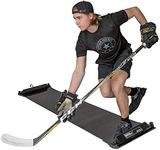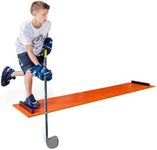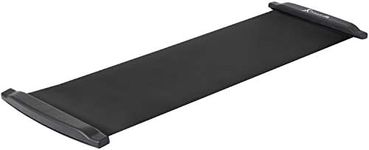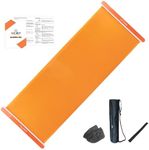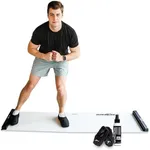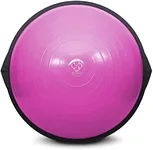Buying Guide for the Best Sliding Board For Hockey
Choosing the right sliding board for hockey can significantly enhance your training and performance. A sliding board is a valuable tool for improving your lateral movement, balance, and agility, which are crucial skills for hockey players. When selecting a sliding board, it's important to consider several key specifications to ensure you get the best fit for your training needs. Understanding these specs will help you make an informed decision and get the most out of your purchase.LengthThe length of the sliding board is crucial because it determines the range of motion you can achieve during your training. Sliding boards typically range from 5 to 8 feet in length. A shorter board (around 5-6 feet) is suitable for beginners or those with limited space, as it allows for basic lateral movements. Intermediate users might prefer a medium length (6-7 feet) for more extensive drills. Advanced users or those looking to maximize their training might opt for a longer board (7-8 feet) to practice full-range lateral movements. Consider your skill level and the space available when choosing the length.
WidthThe width of the sliding board affects stability and comfort during use. Most sliding boards are around 20-24 inches wide. A wider board provides more stability and is generally more comfortable for users, especially beginners who are still mastering their balance. Narrower boards can be more challenging and are often preferred by advanced users looking to increase the difficulty of their workouts. Think about your current balance skills and how much challenge you want in your training when selecting the width.
Surface MaterialThe surface material of the sliding board impacts the smoothness and durability of your slides. Common materials include high-density polyethylene and other slick, durable plastics. A smoother surface allows for easier and more fluid movements, which is important for effective training. Durability is also key, as a high-quality surface will withstand regular use without wearing down quickly. Look for a board with a smooth, durable surface to ensure a consistent training experience.
End StopsEnd stops are the barriers at each end of the sliding board that prevent you from sliding off. They are essential for safety and effective training. Some boards have fixed end stops, while others have adjustable ones. Fixed end stops are generally more stable and suitable for beginners. Adjustable end stops offer more flexibility and can be tailored to different drills and user heights, making them ideal for more advanced training. Consider your training needs and whether you prefer the stability of fixed stops or the versatility of adjustable ones.
PortabilityPortability refers to how easy it is to transport and store the sliding board. Some boards are designed to be lightweight and foldable, making them easy to carry and store when not in use. This is particularly important if you plan to use the board in different locations or have limited storage space. If portability is a priority, look for a board that is easy to fold and comes with a carrying case. If you have a dedicated training space, portability might be less of a concern.
Included AccessoriesSome sliding boards come with additional accessories such as booties (special socks for sliding), carrying cases, or instructional DVDs. Booties are important for reducing friction and ensuring smooth slides, while carrying cases enhance portability. Instructional DVDs or online resources can provide valuable training tips and exercises. Consider what accessories are included and how they might enhance your training experience. If you're new to using a sliding board, having instructional materials can be particularly helpful.

